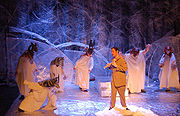
Arctic Magic Flute
Encyclopedia

The Magic Flute
The Magic Flute is an opera in two acts composed in 1791 by Wolfgang Amadeus Mozart to a German libretto by Emanuel Schikaneder. The work is in the form of a Singspiel, a popular form that included both singing and spoken dialogue....
by Ryan Conarro, Joyce Parry Moore and William Todd Hunt, setting the action in northern Alaska at an unspecified post-apocalyptic future date.
Performance History
Arctic Magic Flute premiered on February 8, 2007, in Juneau, Alaska, with Conarro as the stage director, Hunt as the music director, and Joyce Parry Moore, who first conceived the idea for the show and approached Conarro about writing it, as Pamina. Set Design by Sheila Wyne, Light Design by Calvin Anderson, and Costume Design by Marilyn Wright.The show subsequently toured to Kotzebue
Kotzebue
Kotzebue is the name of the following people:*August von Kotzebue, dramatist*Otto von Kotzebue, navigatorKotzebue is also the name of a place:*Kotzebue, Alaska*Kotzebue Sound...
and Nome, Alaska
Nome, Alaska
Nome is a city in the Nome Census Area in the Unorganized Borough of the U.S. state of Alaska, located on the southern Seward Peninsula coast on Norton Sound of the Bering Sea. According to the 2010 Census, the city population was 3,598. Nome was incorporated on April 9, 1901, and was once the...
, where it received a warm reception, and to the Alaska Native Heritage Center
Alaska Native Heritage Center
The Alaska Native Heritage Center is an educational and cultural institution for all Alaskans, located in Anchorage, Alaska. The center opened in 1999. The Alaska Native Heritage Center shares the heritage of Alaska's 11 major cultural groups....
in Anchorage, Alaska
Anchorage, Alaska
Anchorage is a unified home rule municipality in the southcentral part of the U.S. state of Alaska. It is the northernmost major city in the United States...
.
Differences from Schikaneder's Libretto
In addition to being translated into English, the story has been re-cast in (post)modern Alaska instead of the mythical world of the original. Tamino survives a plane crash, rather than fighting a dragon. The Queen of the Night becomes 'the Electric Queen,' a personification of the modern urban world and its reliance on technology. Sarastro becomes an Alaska Native elder.The Masonic
Freemasonry
Freemasonry is a fraternal organisation that arose from obscure origins in the late 16th to early 17th century. Freemasonry now exists in various forms all over the world, with a membership estimated at around six million, including approximately 150,000 under the jurisdictions of the Grand Lodge...
allegory of the original opera is replaced by the traditional values
Traditional values
Traditional values refer to those beliefs, moral codes, and mores that are passed down from generation to generation within a culture, subculture or community.-Summary:Since the late 1970s in the U.S., the term "traditional values" has become synonymous...
of Inupiaq culture; the characters must learn to work with each other, and respect the land and the wild animals, in order to survive a world where modern technology has been taken away from them.
The character of Monostatos has been eliminated, shortening the opera and avoiding controversy about his portrayal. His pursuit of Pamina and Papageno near the end of Act I is replaced by having a pack of wolves—the same animals tamed by the flute in the pantomime scene—surround the escaping pair. The two helmeted men have also been eliminated from Act II.
Papageno's character remains almost unchanged - a bird hunter being a plausible rural Alaskan occupation - but the majority of the jokes in his spoken scenes have been replaced by ones topical to the region, the lock on his mouth becomes a bird-beak, and his glockenspiel becomes a rattle made of driftwood and seashells.
Differences from Mozart's music
Arctic Magic Flute is performed without an orchestral overture. In its place, the show is opened by an Inupiaq dancer and drummer singing a song of welcome, and a short spoken scene introducing the cast of villagers and describing their world. The rest of the opera is framed as a story being told to a young boy by his family.Several numbers have been omitted to shorten the opera - most of the scenes in Act II with the priests, the trio for Sarastro, Pamina, and Tamino, Papageno's suicide attempt, and the numbers involving the deleted characters. Some of the remaining numbers have been resequenced for dramatic reasons: "In diesen heil'gen Hallen," for example, has become the reuniting of Tamino and Pamina in preparation for the Trial of Fire, with completely new words rather than a translation of the German.
The orchestration was reduced to enable it to be performed by a small travelling company. The string parts were essentially unchanged but played by one person each. The woodwind and brass material has been re-distributed to be covered by one flute, one oboe, two clarinets (one alternating on bass clarinet), and euphonium. This was influenced in part by lack of availability of a bassoonist, and does not necessarily reflect Hunt's concept of an optimal reduction of Mozart's orchestra.
External links
- The Nome Nugget's coverage of the February 17, 2007 production in Nome
- Opera to Go!, the company that commissioned and premiered Arctic Magic Flute
- Seth Kantner, Opera organizer works Mozart magic in Kotzebue, Anchorage Daily NewsAnchorage Daily NewsThe Anchorage Daily News is a daily newspaper based in Anchorage, Alaska, in the United States. It is often referred to colloquially as either "the Daily News" or "the ADN"...
, March 4, 2007

